- Under the Surface
- Partnerships
- Big Science for Big Challenges
- Research Expeditions
- Sustained Observations
- Marine Physics and Ocean Climate
- Marine Systems Modelling
- Ocean BioGeosciences
- Ocean Technology and Engineering
- Publications
- Data and Research Facilities
- Educational Resources
- Marine Autonomous and Robotic Systems
- Into the Blue Podcast
- Latest News
- Autonomous Vehicles
- Electronics, Software and Communcations
- Instruments and Sensors
- Mechanical Engineering
- Autosub Development
- Long Endurance Marine USVs
- Deep Ocean Landers
- Marine Robotics Innovation Centre (external link)
- National Marine Equipment Pool
- Research Ships
- British Oceanographic Data Centre (external link)
- British Ocean Sediment Core Research Facility (external link)
- Culture Collection of Algae and Protozoa (external link)
- Discovery Collections
- National Tidal and Sea Level Facility (external link)
- NERC Data Catalogue Service (external link)
- Permanent Service for Mean Sea Level (external link)
- RRS Discovery
- RRS James Cook
- Net Zero Oceanographic Capability
- Coastal and Shelf Seas Instrumentation Services
- Laboratories, Workshops and Testing Facilities
- Archives and Special Collections
- NOC Research Publications
- Open Access Information and Data Resources
- Opening Times (external link)
- Hosting Events at NOC Southampton
- Industry Expertise (external link)
- Collaboration (external link)
- Software (external link)
- National Capability and Science Infrastructure
- Coordinating UK Marine Science
- Impartial Advice
- International Forums
- Working with Developing Countries
- UK G7 Marine Science Coordination
- Working with Partner Agencies
- Learned and Professional Societies
- Doctoral Training Partnerships
- Graduate School, NOC Southampton
- GSNOCS Postgraduate Projects
- PhD Opportunities at NOC Liverpool
- University of Liverpool (external link)
- University of Southampton (external link)
- Online Learning
- Coastal Walk
- Visits and Talks
- Boaty McBoatface
- National Oceanographic Library
- Marine Life Talks
- Vision, Mission, Goals and Values
- Public Benefit
- Leadership and Governance
- Literature and Brochures
- Our Commitments
- Our History and Heritage
- Our Ambassadors
- Staff Directory
- Contact Form
- Ocean Education
- Supplying to Us
- Sustainable Procurement
- Media Centre
- Latest Events
- News Archive
- Current Vacancies
- Working for NOC
- Recruitment FAQs
- Women in NOC
- Women in Engineering
- New Starter Portal
Search form

The RRS James Cook
- NOC Innovations
- The RRS Discovery
- RRS James Cook Virtual Tour
- Past, Present, Future
- History of Research Ships
- Hire of Research Vessels
Since arriving at the National Oceanography Centre on 31 August 2006, RRS James Cook has undertaken research expeditions focusing on a range of scientific disciplines in some of Earth’s most challenging environments, from tropical oceans to the edge of ice sheets.
RRS James Cook Virtual Tour
Explore one of the world’s most advanced research vessels from the bridge to the engine room.
The RRS James Cook is fitted with cutting edge scientific instruments and hosts a wide array of scientific investigations on-board, making her one of the most advanced research vessels currently in service.
- Single and multi-beam echo sounder surveys
- Seismic surveys
- Clean seawater sampling
- Remotely Operated Vehicle operations
- CTD surveys
- Deep-water coring, trawling, and towing
- Integrated data logging
- Adaptable laboratory space
- Length: 89.2 metres
- Beam: 18.6 metres
- Maximum draft: 6.315 metres
- Gross tonnage: 5,401 tonnes
- Nett tonnage:1,620 tonnes
- Average operating speed: 10 knots
Scientific facilities
Handling equipment.
The RRS James Cook is the most capable ship in the NERC fleet in terms of over-the-side handling capability with both the stern and mid-ships’ ‘A’ frames built with safe working loads of up to 30T. In addition, the ship has a comprehensive winch suite capable of supporting all current and anticipated future scientific operations.
Laboratories
The ship contains a range of laboratory spaces that can be flexibly configured to support multiple scientific activities on each expedition. RRS James Cook has plentiful laboratory spaces sub-divided into ultraclean, clean, normal, and temperature-controlled areas, with sufficient flexibility to be used for multiple needs. There is also the option to configure the lab spaces to ‘wet’ or ‘dry’ labs, depending on the nature of the science being undertaken. Container labs enable scientists to work on samples they have collected in controlled conditions, which may involve the use of radioactive substances or may entail ‘clean chemistry’ procedures. The RRS James Cook has 278m 2 of laboratories, as well as positions for up to seven 6 m (20 ft) container laboratories on deck.
Permanently fitted sensors and instrumentation
Research ships come with a range of inbuilt equipment that scientists use on an expedition. The systems enable a wide variety of parameters to be continuously logged whether the ship is stationary or carrying out scientific work.
Hydroacoustic suite
The RRS James Cook is fitted with a complex and highly capable suite of acoustic instruments designed to:
- map the seabed, both coastal and deep ocean;
- measure currents;
- measure the abundance of fish and other biomass; and
- accurately position scientific platforms and sensors deployed by the vessel.
Bridge equipment and propulsion
Bridge equipment.
The RRS James Cook has modern bridge equipment including a dynamic positioning system.
The ship is configured with a novel azimuth thruster propulsion system configuration compared to a conventional fixed shafts/propellers and rudders. The thrusters can be independently rotated through 360° which will make the vessel extremely manoeuvrable.
On-board equipment
RRS James Cook has a range of in-built equipment, enabling scientists to collect unique samples and undertake specialist measurements during oceanic research expeditions. An overview of capabilities and technical specifications are given below.
Timing and Positioning Systems
There are two independent GPS systems installed for science. The accuracy of these acquired positions are further augmented by the supply of correction data from the CNav system which provides differential GPS data to the two systems. The ship is fitted with a satellite timeserver (a Network Time Protocol clock) which receives high-accuracy time updates via satellite. This is fed into the ship’s network to provide an accurate time reference for all computer systems.
Applanix PosMV
Kongsberg 300+
Oceaneeering C-Nav 3050
Meinberg LANtime M300
Air and Surface Water Sampling
The Surface Water and Meteorological monitoring system (SurfMet) utilises scientific instruments to continuously measure surface water properties and the meteorology. Scientists use these measurements to aid regional and global climate models. A wave radar is used to monitor ocean waves; this is located half-way up the main mast.
Surface water: temperature, salinity, chlorophyll and particulate matter.
SeaBird SBE38
SeaBird SBE45 MicroTSG
WetLabs WS3S
Wetlabs C-Star Transmissometer
Meteorology: temperature, humidity, wind speed and direction, air pressure and light (port and starboard). All instruments are located on the forward mast.
Vaisala HMP45
Gill Windsonic
Vaisala PTB110
Skye PAR SKE510
Kipp & Zonen TIR CM6B
Wave radar:
Ocean Waves WaMoS II
Furuno FR-1500 MkIII
Echo Sounders and Sound Velocity
RRS James Cook has several echo sounder transducers built into her hull. These emit pulses of sound through the water column, which bounce back when they hit an object. Echo sounders are used for navigational purposes, seafloor mapping and detecting fish or other objects in the water column. The accuracy of all acoustic systems depends on the knowledge of the speed of sound through the water column. The Kongsberg system gets the speed of sound at the echo sounder from a probe which is installed in the port drop keel.
Kongsberg EA640 10/12 kHz single beam echo sounder
Kongsberg EM122 Multibeam echo sounder
Kongsberg SBP120 Sub-bottom profiler
Kongsberg Simrad EK60 Fish Finder
Kongsberg K-Sync Unit
AML Micro-X Sound Velocity probe
Ultra Short Base Line
Ultra Short Base Line (USBL) is a technique used to measure the distance of an underwater object relative to the ship. Using sound, the USBL beacons communicate with transducer heads which are deployed through the hull of the ship. Beacons are placed on remotely operated vehicles, towed vehicles and drills to determine their location to a high degree of accuracy when they are deployed.
Sonardyne HPT5000/7000 USBL Transceivers
Sonardyne NSH
Acoustic Doppler Current Profilers
Acoustic Doppler Current Profilers (ADCPs) are used to measure the velocity (speed and direction) of the water column. They emit sound waves and use the Doppler effect to detect the current over a range of depths, giving a two-dimensional profile.
Teledyne RD 75 and 150kHz ADCPs , measuring to depths of 700 and 400 m respectively.
Geoscience Systems
A gravity meter is installed to measure the relative change in gravity. This instrument is cradled in an actively-compensated gimbal in a shock-mounted frame, allowing the meter to stay level as the ship moves around it. The gravity data needs to be grounded against an absolute gravity measurement on land. This measurement is taken at each end of the ship’s passage, using a land gravity meter to take readings at a known Gravity Base Station. The ship also has the capability to deploy a towed magnetometer. The magnetometer is ~1.5m long with fins and is typically deployed using the port-side aft boom, with a 300m layback from the ship.
Micro g LaCoste Air-Sea System II Gravity Meter
Marine Magnetics SeaSPYII Marine Magnatometer
Computing, Network and Data Acquisition Network
Two data acquisition systems work in parallel on RRS James Cook . Raw, unprocessed data are recorded by the NMF Research Vessel Data Acquisition System (RVDAS). Ifremer’s TECHnical and Scientific sensors Acquisition System (TECHSAS) is configured with a range of modules that are programmed to parse and build structured data as it is received. Data from the acquisition systems, hydro-acoustic suite and other sources are aggregated by a central file system server which stores it onto a multi-redundant (RAID) network storage system. Data from this is backed up to hard disks which are provided to the scientists at the end of each cruise.
Satellite Internet and Phones
RRS James Cook is fitted with a C-band VSat antenna which is subscribed to a time-division-multiple-access (TDMA) internet connection service over satellite. This provides the ship with a guaranteed download speed of 1.5Mbps (~183kB/s), a guaranteed upload speed of 1.5Mbps (~183kB/s) and four telephone lines when a stable link has been established. The TDMA allows bursts of up to 10Mbps, depending on whether there are other ships using the same satellite. The ship is also fitted with a pair of Thrane&Thrane Cobham Sailor 500 antennae which provide up to 256 kbps (~32kB/s) internet and a satellite phone.
IT Provision on NMF-Operated Ships
Winch systems
Scientific winches are used to:
- Lower sensor packages such as Conductivity, Temperature and Depth (CTD) sensors through the water column;
- Lower coring systems to the seabed to obtain samples from the seabed and sub-seabed;
- Tow platforms such as the Towed Ocean Bottom Instrument (TOBI) for seabed mapping;
- Tow undulating sensor platform to measure water properties while underway;
- Tow deep-sea trawling and net systems.
The permanently fitted winches live in the bottom of the ship, where the wire is fed up to the gantries on deck. The table below shows the types and properties of the permanently fitted winches found on our ships.
- Virtual tours
RRS James Cook Virtual Tour
Explore one of the world’s most advanced research vessels from the bridge to the engine room. Head out on to the deck and take in the virtual sea air, and then crawl into one of the lifeboats. And along the way you can find out about the labs and equipment on board that enable marine scientists to study and measure the ocean in some of the most remote and challenging environments on the planet.

- 1 minute read
- Maritime and me
Marine Engineering Apprentice
- 2 minute read

Charlie Telfer and Wilson Rebello, City Cruises

- Virtual lessons
How to get a job in marine biology

Research Vessel Virtual Tour - RRS James Cook

Explore one of the world’s most advanced research vessels from the bridge to the engine room. Head out on to the deck and take in the virtual sea air, and then crawl into one of the lifeboats. And along the way you can find out about the labs and equipment on board that enable marine scientists to study and measure the ocean in some of the most remote and challenging environments on the planet.
How to use this resource
The tour uses photographic imaging and 360° scanning technology to enable you to take immersive journeys through the ship to get a feel for what life is like on board. You can zoom in and out and move the image around for a full 360° view and explore hotspots on each deck. Use the icons at the bottom left of the screen (on desktop) to select your view and how you want to navigate. Choose to follow the camera as it guides you around, or take control and explore every corner. The models also work on mobile devices and offer a VR experience using Google Cardboard.
ISCED Categories
Contributor(s), further details.

- Introduction
- Jacques Cartier
- Hugh Palliser
- Harold “Hank” Williams
- Robert K. Stevens
- Ancient Continental Slope
- Transported Continental Margin
- Table Mountain Massif
- North Arm Massif
- Blow Me Down Massif
- Lewis Hills Massif
- Little Port Island Arc Complex
- Virtual Reality
- Blow Me Down East Virtual Tour
- Bottle Cove Virtual Tour
- Corner Brook Virtual Tour
- Three Bear Mountain Virtual Tour
- Saltbox Restaurant Virtual Tour
- Gregory Mountains Virtual Tour
- Humber Valley Virtual Tour
- Little Port Virtual Tour
- South Head Virtual Tour
- Trout River Virtual Tour
- Blow Me Down West Virtual Tour
- Simms Gulch East Virtual Tour
- Wheelers Gulch East Tour
- Burnt Hill Virtual Tour
- Photo Gallery
- Trails By Region
- UltramaTrex
- Trout River Trails
- Other Trails
- Stone Brook Basecamp
- Trout River
- Captain Cook B&B and Cottages
- Blow Me Down Provincial Park
- Elephants Head RV Park
- Trout River Campground
- Saltbox in Benoit’s Cove
- Everoutdoor in Benoit’s Cove
- Transportation
- Snowmobiling
- Snowshoeing
- Palliser In Western Newfoundland
- Cook In Newfoundland
- Making of a Maritime Explorer
- French Raid on Newfoundland Fishery
- A Two Sided Symmetrical System
- Geology of the Appalachian Orogen
- An Appreciation
- Geology of Humber Arm Area
- Lithostratigraphy & Structure
- Stratigraphy of Sedimentary Rocks
- Structure & Polyphase Deformation
- Development of a Folded Thrust Stack
- Structural Architecture & Evolution
- Eastern Alpine Guide
- Geopark Overview
- GIS – Geology, Ecology and History
- Humber Arm Allochthon Map, 1989
- Cabox Geological Zones
- Harold Williams Geology Map of Newfoundland, 1967
- Geological Map of Newfoundland, 2004
- The Mapping of Newfoundland
- Chart of the West Coast of Newfoundland, 1768
- Tectonic Lithofacies Map of Appalachian Orogen, 1978
- Appalachian-Caledonian Orogeny
- Appalachian-Caledonian Orogenic Belt
- UNESCO Global Geoparks
- Canadian Geoparks
- European Geoparks
- Drifting Apart
- Geopark Plus
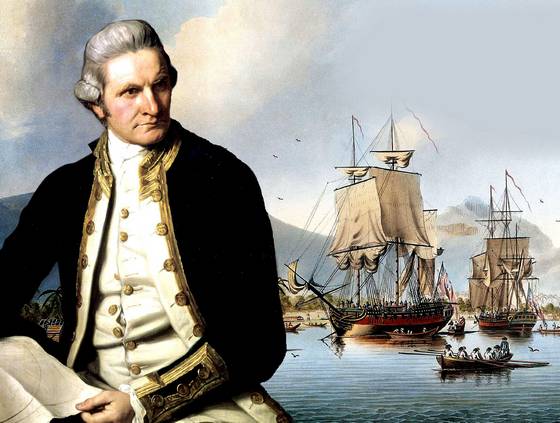
Widely considered the greatest mariner of all time, British Navy explorer, surveyor and cartographer James Cook charted the Bay of Islands and Humber River in 1767. While preparing his ‘Chart of the West Coast of Newfoundland’ in April 1768, the British Admiralty and Royal Society selected him to command a voyage to the Pacific Ocean to witness the Transit of Venus and search for the fabled southern continent. In all Cook commanded 3 voyages to the Pacific, where he discovered and surveyed the coasts of New Zealand and eastern Australia, circumnavigated Antarctica, explored the northwest coast of North America, searched for the western entrance to the Northwest Passage, and discovered numerous Pacific Islands, including the Hawaii Islands where he was killed by natives in 1779. During his 5 years surveying the coasts of Newfoundland, Cook produced the first large-scale accurate maps of the island and the first large-scale hydrographic surveys using precise triangulation to establish land outlines. He then anticipated Captain James T. Kirk and professed his intent to go not only “farther than any man has been before me, but as far as I think it is possible for a man to go”.
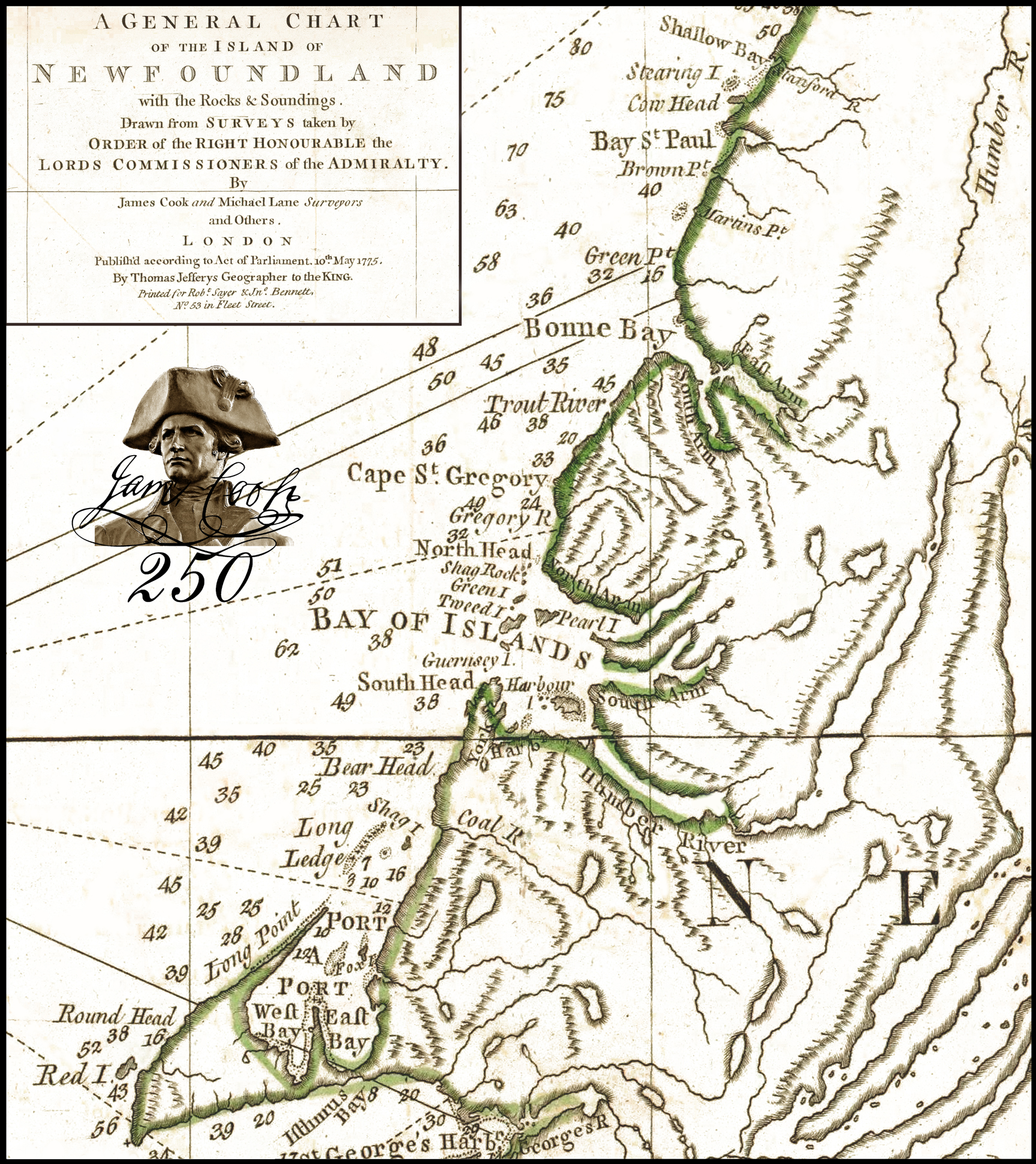
Bay of Islands and Bonne Bay on Cook’s General Chart of the Island of Newfoundland (1775)
The story of James Cook begins in the village of Marton in Yorkshire, England, where in 1728 he was born the second of eight children to a Scottish farm labourer and his Yorkshire wife. In 1736 his family moved to nearby Great Ayton where his father’s employer paid for his schooling. In 1745 at the age of 16, Cook moved to the ocean, first to the fishing village of Staithes and 18 monthes later to the seaport of Whitby, where he worked for John and Henry Walker as merchant navy apprentice. His training included algebra, geometry, trigonometry and astronomy. After three years of plying the east coast of England, Cook began working on trading ships in the Baltic Sea and in 1755 volunteered for service in the Royal Navy, just one year before the outbreak of the Seven Years War. In 1757 Cook passed his Master’s examination and was soon headed to Canada as Master of the 64-gun HMS Pembroke.
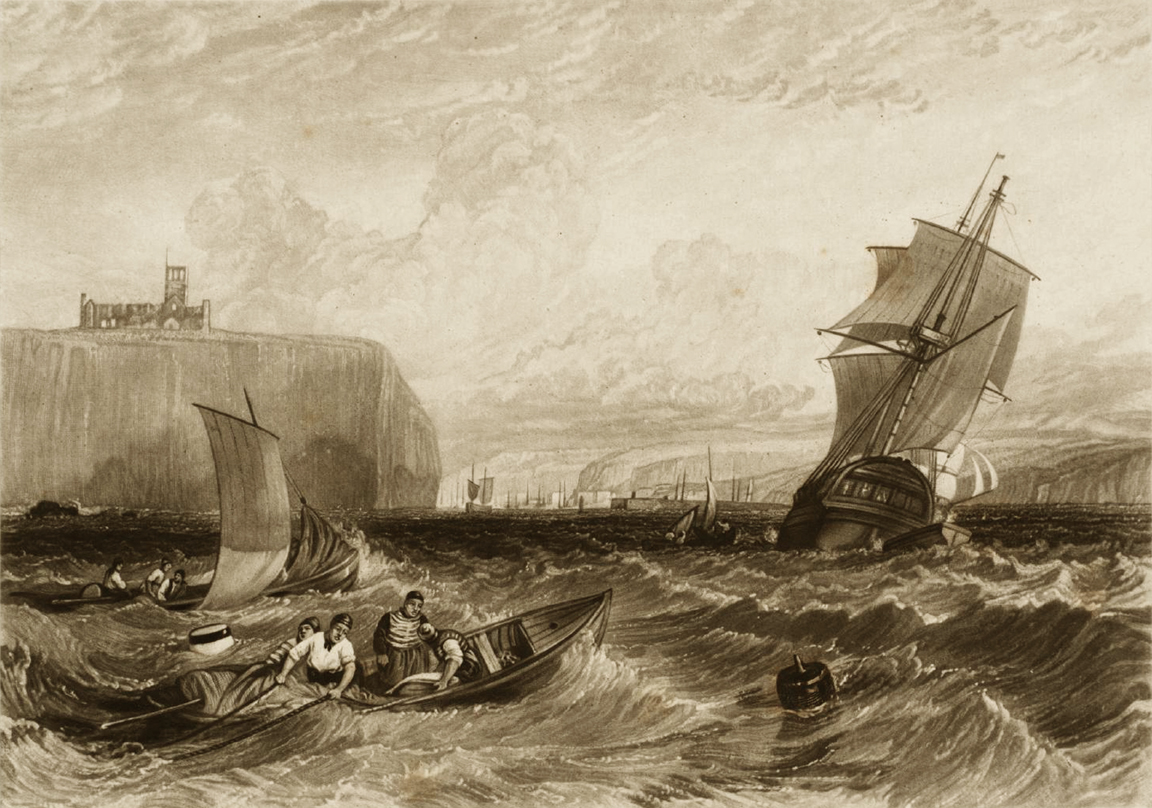
Whitby after Joseph Mallord William Turner, 1826
As Master of a Royal Navy vessel, Cook was responsible for sailing the ship as directed by the Captain, whose primary role was carrying out the Navy’s strategy and tactics while engaging the enemy. The Master’s primary duty was navigation, which required determining the vessel’s position, speed and direction, while observing the weather and setting the sails. The Master was also responsible for making charts, fitting out the vessel and stowing the hold, as well as docking and undocking the ship at port.
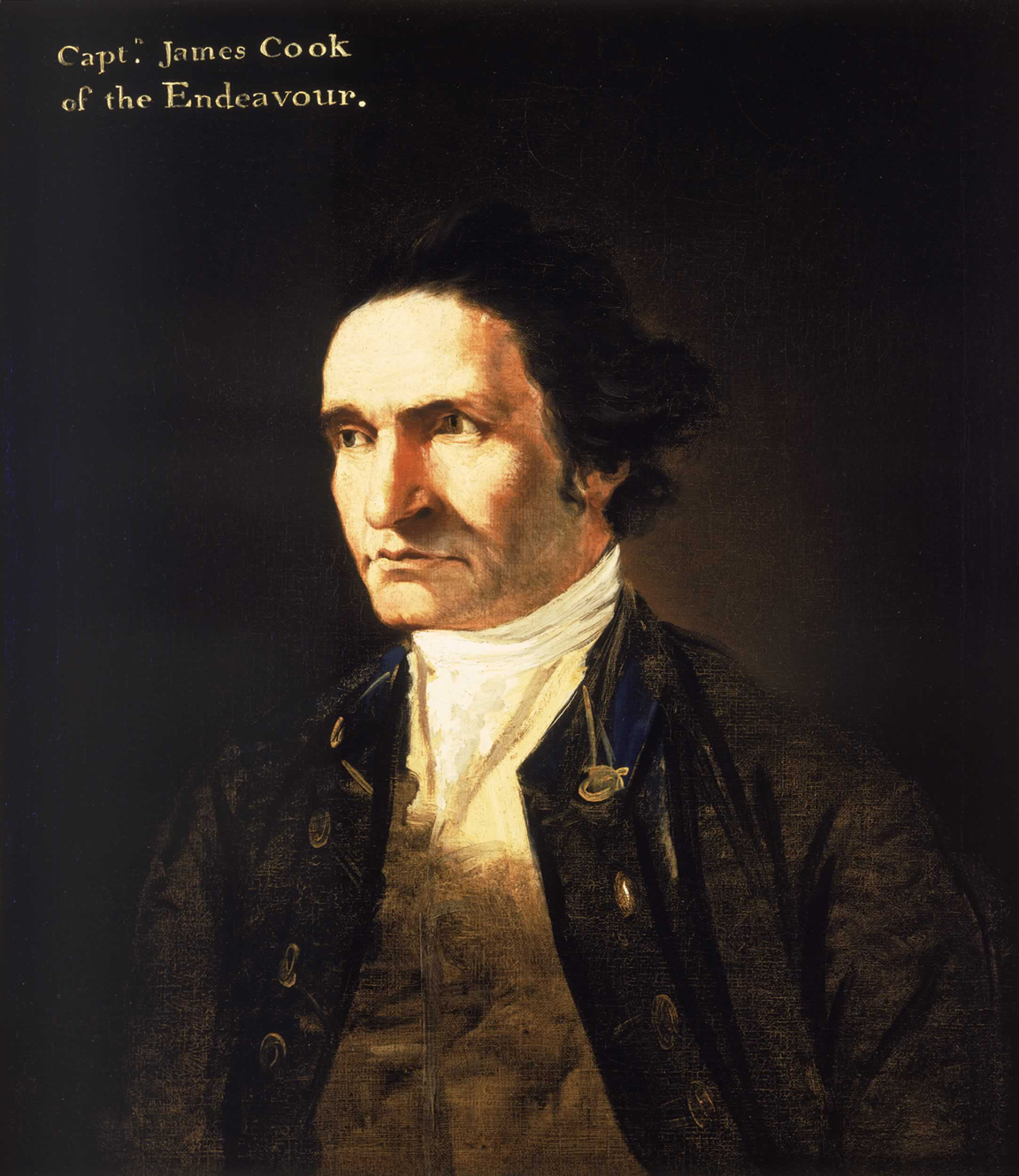
Portrait of James Cook by William Hodges (c. 1775-76), official artist on Cook’s Second Voyage to the Pacific Ocean (1772-74)
A year after arriving in Canada and taking part in the successful attack on the fortress of Louisbourg in Nova Scotia, Cook met Royal Navy Engineer Samuel Holland who taught him the latest techniques in surveying and map making, including use of the plane table. Soon after during the summer of 1759, Cook played a major role in surveying the St. Lawrence River in preparation for the assault on Quebec, where Major General James Wolfe and his forces defeated the French on the Plains of Abraham. In recognition of his role in the victory, Cook was promoted to Master of the 70-gun Northumberland, flagship of Commander-in-Chief Lord Colville. For the next three years he honed his new skills while stationed in Halifax. They were put to use again in July 1762 when a last French attempt to secure bargaining power in the peace treaty to end the Seven Years’ War led to an attack on St. John’s and other ports on Newfoundland’s Avalon Peninsula. Northumberland took part in the combined fleet that successfully forced the French out of Newfoundland waters, with Cook producing charts of Placentia and St. John’s harbours and the fishing ports of Harbour Grace and Carbonear.

With the French defeat in North America, Great Britain acquired new territories which required surveying and mapping. After being impressed by the quality of Cook’s work on the Avalon Peninsula, Governor Thomas Graves urged the Admiralty to commission Cook to continue surveying the coasts of Newfoundland and the newly acquired Labrador. The Admiralty agreed and in the summer of 1763 Cook became the Surveyor of Newfoundland, beginning with the south coast islands of St Pierre and Miquelon which were soon to be handed over to the French under the Treaty of Paris. Cook then surveyed the Strait of Belle Isle (1763-64), south coast between the Burin Peninsula and Cape Anguille (1765-66) and the west coast between Cape Anguille and Point Ferolle (1767), when he penetrated up the Humber River as far as Deer Lake in the first official attempt to delineate the inland topography of the island. In autumn of each year Cook would return home to his family in London where he would spend the winter completing the previous summer’s charts and sailing directions, then prepare for the next summer’s exploration and surveys.

To save time and reduce dependency on British Navy vessels, Governor Graves provided Cook with a New England schooner re-rigged as a brig, with square sails better suited to inshore maneuvers. Cook’s role as its commander, navigator and surveyor combined with his knowledge of astronomy ( in 1766 Cook scientifically observed an eclipse of the sun near Burgeo) brought him to the attention of the British Admiralty and Royal Society when they were planning an expedition to the Pacific Ocean to witness the Transit of Venus and search for the fabled southern continent. In April 1768 while working on his ‘Chart of the West Coast of Newfoundland’, Cook accepted the position of commander of HMS Endeavour and readied the bark for an August departure. His surveying assistant Michael Lane continued his work in Newfoundland and together they produced the ‘General Chart of the Island of Newfoundland’.

Mid section of Cook’s Chart of the West Coast of Newfoundland, including Geopark region
Cook’s contribution to the British Empire were many and included victory in North America during the Seven Years War, creation of highly accurate charts for the Newfoundland fishery, expansion of the empire into the Pacific Ocean and Northwest North America, and health and dietary innovations for the British Navy. According to his monument near Admiralty Arch, London: “Captain James Cook, Circumnavigator of the globe and explorer of the Pacific Ocean, he laid the foundations of the British Empire in Australia and New Zealand, charted the shores of Newfoundland, and traversed the ocean gates of Canada both east and west.” Cook’s contribution to Newfoundland also included the designation of many place names and the cartographic delineation of the island, to be “coloured in” by generations of geologists, from J. B. Jukes to Alexander Murray, James Howley, Harold Williams, Robert Stevens and their esteemed colleagues at the Newfoundland & Labrador Geological Survey.
Route 450 on the South Shore of the Bay of Islands is named Captain Cook’s Trail in honour of James Cook. James Cook Heritage Trail in Blow Me Down Provincial Park and Cape Blow Me Down Trail in York Harbour were named in 2017 to commemorate the 250th Anniversary of Cook’s surveying and charting the West Coast of Newfoundland, including the Bay of Islands and Bonne Bay.
To learn more about James Cook in Newfoundland, check out the below documents from our information archive
- James Cook in Newfoundland, 1762-1767
- The Making of a Maritime Explorer, James Cook In Newfoundland, 1762-1767
- The French Raid on the Newfoundland Fishery, 1762
or visit our James Cook 250 Anniversary website .
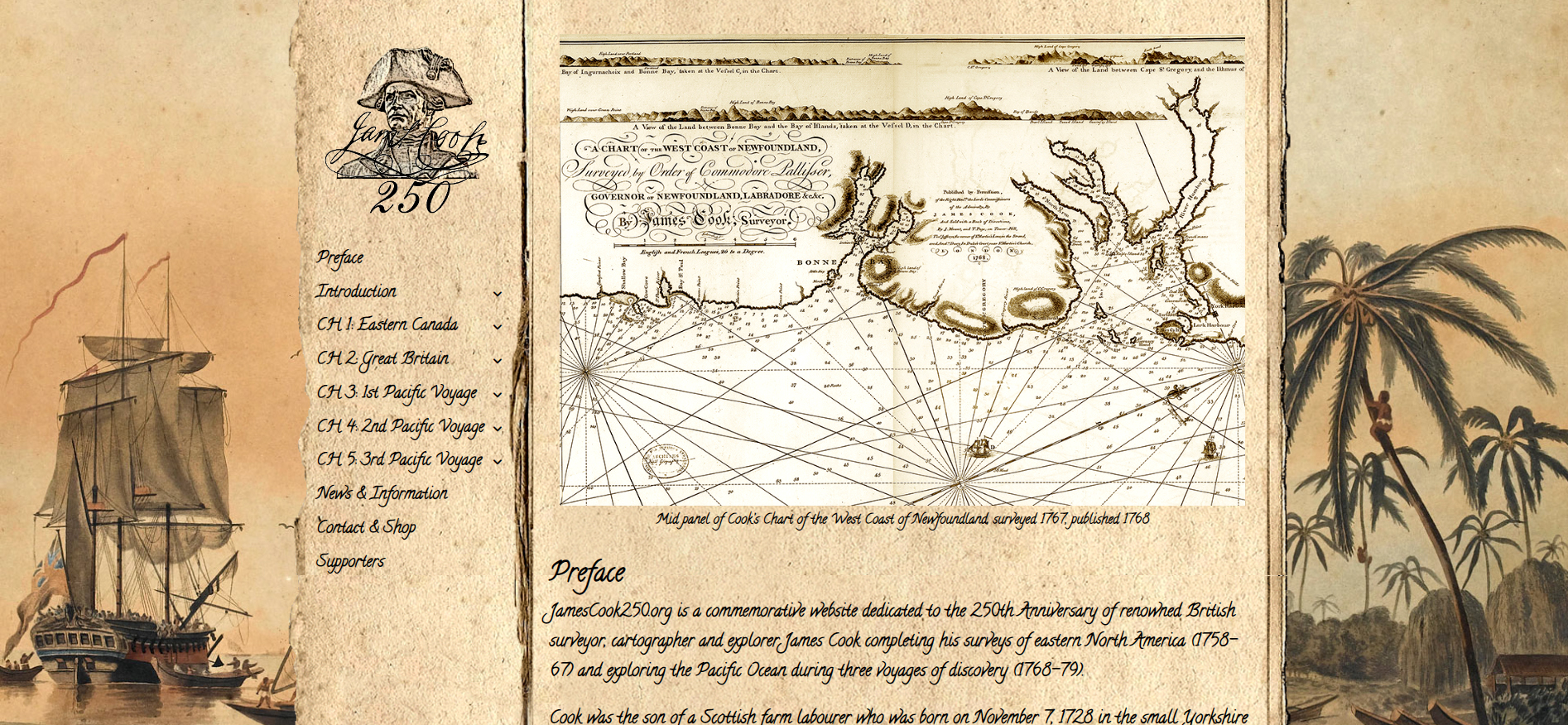
Inspiration Gallery
- Ideas Studio

Tour a leading Oceanographic Research Vessel
- Computer Science
- Engineering
Explore the RRS James Cook, one of the world’s most advanced research vessels from the bridge to the engine room. Head out on to the deck and take in the virtual sea air, you can even crawl into one of the lifeboats. Along the way you can find out about the laboratories and equipment on board that enable oceanographers to study and measure the ocean in some of the most remote and challenging environments on the planet. You can meet scientists and see their science and careers through interactive demos.

The tour uses photographic imaging and 360° scanning technology to enable you to take immersive journeys through the ship to get a feel for what life is like on board. You can zoom in and out and move the image around for a full 360° view. Choose to follow the camera as it guides you around, or take control and explore every corner.
You are using an outdated browser. Please upgrade your browser to improve your experience and security.
Marine Industry News
- Leisure Marine
- Maritime, Commercial & Defence
- Boats and Outboards
- Construction Materials
- Engines and Propulsion Systems
- Marina and Yard
- Marine Electronics
- Safety Equipment
- People on the move
- Shows & Events
Explore research ship RRS James Cook
Friday, June 19th, 2020
Written by: Marine Industry News
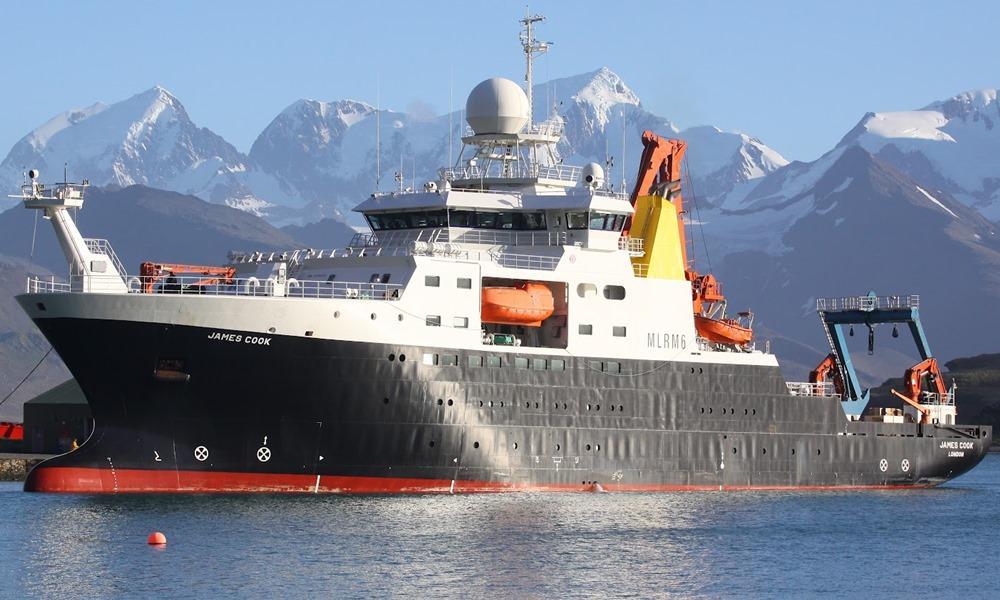
The National Oceanography Centre has introduced virtual exploration of one of the world’s most advanced research vessels to its website to mark the recent World Oceans Day.
Visitors can venture round the RSS James Cook from the bridge to the engine room, head out on to the deck and take in the virtual sea air before crawling into one of the lifeboats. Along the way, it’s possible to find out about the labs and equipment on board that enable marine scientists to study and measure the ocean in some of the most remote and challenging environments on the planet.
The tour uses photographic imaging and 360° scanning technology, enabling a visitor to take an immersive journey through the ship to get a feel for what life is like on board.
Take the tour here .
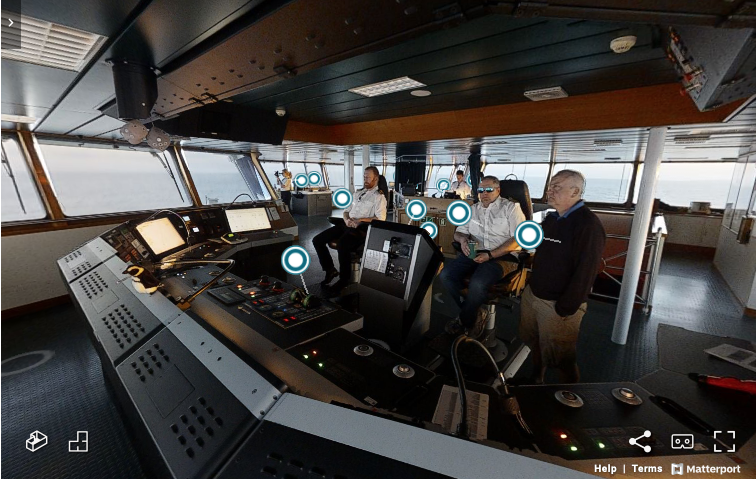
Paddle Centre at Swanwick Marina now open

New E40i electric winch from Seldén Mast simplifies short-handed sailing
Comments are closed.

MIN magazine
Dive into MIN’s print edition which is now online for your convenience. More stories, more in-depth features, more product news and more exclusive interviews. Enjoy thoughtful analysis of the marine trade sector from across the world and get onboard with new trends.

Privacy Overview
You are using an outdated browser. Please upgrade your browser to improve your experience and security.

- Buy Tickets
- Join & Give
The Australian Museum's Unsettled exhibition
Curated by laura mcbride and dr mariko smith.
- Share this page:
- Share on Facebook
- Share on Twitter
- Share on Linkedin
- Share via Email
- Print this page

This exhibition has now closed. Please explore the virtual tour capture below.
Curators’ Acknowledgement
We pay our respects and dedicate the Unsettled exhibition to the people and other Beings who keep the law of this land; to the Elders and Traditional Owners of all the knowledges, places, and stories in this exhibition; and to the Ancestors and Old People for their resilience and guidance.
We advise that there are some confronting topics addressed in this exhibition content, including massacres and genocide. Aboriginal and Torres Strait Islander peoples should be advised that there may be images of people who have passed away.
Introduction by Laura McBride, First Nations Director and Curator
Yaama gurra (hello with respect).
In 2018, I was approached to curate the Australian Museum’s Indigenous-led exhibition about Captain James Cook, as a response to the 250th anniversary in 2020 of the HMB Endeavour’s East Coast voyage during 1770. I knew this would be a challenging task. Cook is often celebrated as the founding father of Australia, with hero-like status to non-Indigenous Australians. But he represents the opposite to First Nations peoples: a symbol of destruction and death, pain and suffering. Curating a show about why these differences exist that meets the needs of both these audiences would not be straightforward, especially in Australia’s oldest museum.
To undertake this exhibition in a culturally appropriate way and ensure we accurately represented the views of First Nations peoples on the Cook anniversary, community consultation was undertaken to define what themes and topics would be covered. Most significantly, the consultations illustrated that First Nations peoples did not want another show about Cook; he was but a small footnote in a more expansive history. Instead, we were asked to take the opportunity for long overdue truth-telling about our shared past.
The consultation had three highest-ranking categories for possible exhibition topics: (1) colonisation and its effects; (2) Australia’s origins and foundation; and (3) addressing the false, constructed history that is pervasively shared in society. The most common specific responses were: truth, truth-telling, invasions, wars, massacres, genocide, assimilation, dispossession, resistance, resilience, and survival.
We had our content set by communities, but we needed to name this important exhibition. The First Nations staff, in partnership with independent media, consultancy, and training organisation IndigenousX, spent time brainstorming a title that could capture the importance, meaning and content being covered. We decided on the name “Unsettled”. This term has many connotations and in the context of this exhibition they are everywhere: Australia was not peacefully settled; our history is unresolved; relationships between First Nations peoples and Australians are uneasy; and after 250 years, newcomers still have a turbulent and unbalanced relationship with the natural environment in which they now live.
Truth-telling about Australia’s past is an incredibly important process for understanding who we are now and how we came to be as a nation. Truth-telling can be confronting, but the process can be powerful: grief can make way for healing, and healing unites people who were once divided. It is time we stop pretending that meaningful change can happen in a system that is grounded in denial. Until historic inequities are addressed, the gap between Indigenous peoples and non-Indigenous Australians will only continue to widen.
Museums and other cultural institutions have the opportunity to be at the centre of this process given they are publicly trusted sources of information and knowledge. This requires a spirit of inclusiveness and a commitment to build strong relationships between First Nations peoples and collecting institutions which promote principles of Indigenous agency and self-determination. I applaud the leadership shown by the Australian Museum’s executive leadership team and Trustees for providing First Nations peoples with a platform to be heard and rebalance the narrative.
As sites of public influence and authority, it is important that First Nations peoples control how our cultures, experiences and world views are interpreted in museums. We worked with over 130 Aboriginal and Torres Strait Islander peoples to interpret the topics set out by the consultation data. Every one of these First Nations community members understood the enormity of our task and we have been thanked many times for sharing the stories of individuals or their Ancestors. They had been waiting a long time for this story to be told. I would like to thank every Aboriginal and Torres Strait Islander person who contributed to the exhibition, guided us, and supported us. I hope we have made your Ancestors, families, communities, and you, proud.
It has been an absolute honour and privilege to develop, curate, and now present Unsettled to the public. It has been my most challenging, yet most rewarding professional project. I thank the visitors to the exhibition and readers of the catalogue for embarking on this journey with us. This is how we will build a better shared future – together.
I thank the Australian Museum’s Unsettled team for the hard work, perseverance, and patience on the development of the exhibition. I would also like to thank our First Nations colleagues who assisted us and gave valuable feedback and critical insight.
Lastly, I acknowledge the hard work and dedication of my Yuin colleague and assistant curator, Dr Mariko Smith, maarubaa bawaa (thank you sister).
About Unsettled by Dr Mariko Smith, First Nations Assistant Curator
Unsettled features over 190 objects and images throughout eight thematic sections: Introduction, Signal Fires, Recognising Invasions, Fighting Wars, Remembering Massacres, Surviving Genocide, Continued Resistance, and Healing Nations. These objects and images include Australian Museum collection items, commissions, acquisitions, and loans.
Many of the 53 objects from the Australian Museum’s Aboriginal and Torres Strait Islander cultural collection have never been seen by the public. There is a 30,000-year-old Wailwan grindstone fragment from Cuddie Springs which demonstrates the longevity of food preparation by Aboriginal people, and Yam Island print-maker Glen Mackie’s Storyboat installation which shares a personal cross-cultural family history from the Torres Strait.
90-plus digital acquisitions have been made, including the Dark Days photographic series by photographer Brendan Beirne that feature massacre sites as they look today, and important artworks that illustrate First Nations lived experiences by First Nations artists Nyree Reynolds and Charlotte Allingham (Coffin Birth).
We are proud to welcome over 30 new object acquisitions to the Australian Museum, including works by Aboriginal artists Tony Albert, Karla Dickens, and Aunty Fay Moseley – including Aunty Fay’s One Way Ticket To Hell which took her eight years to complete due to the deeply personal and painful childhood memory of being removed from her parents. She decided to allow the Museum to purchase this work because of its important work in truth-telling.
Significant historical documents attributed to Governor Lachlan Macquarie and others have been loaned from the NSW State Archives and Records, and the State Library of New South Wales. Significant cultural objects have also been loaned from First Nations communities and peoples, such as a killer boomerang made by Kabi Kabi Goori Elder Uncle Dennis Embrey and lent to the Museum for Unsettled by his grandson Uncle Alex Bond.
Explore Unsettled online
Discover the Unsettled exhibition in virtual reality! The online experience above is a 360 degree interactive tour featuring embedded audio guides and multimedia content on display in the exhibition. The virtual tour is ideally viewed via high speed internet connections.
Users in the virtual tour with an Oculus headset can trigger an immersive VR enabled experience. Simply access the tour on your preferred device (Recommended for Oculus Quest 2), click on the VR icon down the bottom right of the screen and select Enter VR.
Please refresh your web browser if you have any issues with media loading. For best playback, we recommend using Chrome web browser.
Our untold history revealed
Australia’s foundation story is more than the voyage of James Cook or the arrival of the First Fleet. It is a story about the seizure of land from First Nations peoples, denial of Indigenous sovereignty, devastating frontier wars, and separation from families and homelands.
We live in the legacy of this history. This has privileged many but has left others disadvantaged. Recognising and understanding this shared past is an important step of our journey towards a better shared future.
This can only be done if we discuss this nation’s history truthfully and listen to First Nations voices which have been absent from Australia’s foundation narratives.
Unsettled uncovers the untold histories behind this nation’s foundation story. In this powerful exhibition, First Nations voices reveal the hidden stories of devastation, survival and the fight for recognition. These first-hand accounts are presented through long hidden historical documents, large-scale artworks, immersive experiences and never-before-seen objects from the Australian Museum collections and beyond.
First Nations Elders including Uncle Waubin Richard Aken (Kaurareg), Aunty Fay Moseley (Wiradjuri) and Uncle Noel Butler (Budawang), share their lived experiences.
Featuring the work of contemporary artists including Ryan Presley, Tony Albert, Charlotte Allingham (Coffin Birth), Jai Darby Walker and Danie Mellor, this free exhibition interrogates the lasting impacts of colonisation and the denial of Indigenous sovereignty.
With more than 80 significant cultural objects and over 100 contributions by First Nations peoples across the country, Unsettled illuminates the power of truth-telling to realise change. Understanding our shared past is an important step towards healing for a shared future.
The exhibition's thematic sections

Unsettled introduction
This can only be done if we discuss this nation’s history truthfully and listen to First Nations voices which have been absent from Australia’s foundation narratives. Read more .

Signal Fires
Knowing the difference between smoking ceremonies, campfires, cultural burning and signal fires is primary knowledge. When Lieutenant Cook sailed the HMB Endeavour up the East Coast in 1770, Aboriginal peoples lit carefully managed signal fires on headlands as a warning. While the ship’s crew noted smoke and fires, they lacked the cultural knowledge to see that an emergency response system was in action.
During the 250th anniversary of the HMB Endeavour voyage, Australia experienced unprecedented bushfires. Many First Nations peoples read this bushfire as another emergency warning – the intensity signalling the seriousness of the danger for all peoples and species due to human-created climate change. Elders continue to teach the importance of knowing our past and acting now for future generations. Read more .

Recognising Invasions
First Nations peoples have been here since time immemorial.* Aboriginal peoples’ homelands were taken by force; it was not a peaceful settlement. The colonists did not make agreements or treaties with any of the sovereign Nations, making the colonial seizure of land in Australia a process that could be described as a series of invasions.
The lack of recognition of dispossession goes to the very heart of a wound in the nation. It has informed the political, social, and economic systems in Australia, resulting in the racial inequity we see today.
For First Nations peoples, it is not merely an opinion that Australia was invaded – it is historical fact.
* For First Nations peoples, this means time so long in the past that it is indefinite in history or tradition. Read more .

Fighting Wars
Australia was not peacefully settled; it was taken by force through strategic, political and military campaigns. The early colony was militarised to protect it from foreign attacks, to maintain civil order over the convict population, and to suppress Aboriginal resistance against colonial interests.
Defining the decades of armed, violent conflicts between sovereign First Nations and the colonists as “wars”, is often contested. However, the historical records from this period included this specific term to describe events on the frontier.
The ongoing refusal to recognise this history of First Nations warriors and their adversaries denies them the memory, and the respect, they deserve. Read more .

Remembering Massacres
Killing became a defining colonial tactic used by government troops, police officers, and even ordinary Australians, to retaliate against the resistance efforts of First Nations peoples defending their homelands, families, and resources.
These were not spontaneous acts of violence on the fringes of “civilisation” – rather these were typically planned and calculated reprisals.
In archival records, “dispersal” is a recognised codeword throughout frontier Australia for the deliberate and indiscriminate killing of Aboriginal people in systemic and widespread attacks across Australia. Massacres exist in the memories of all First Nations communities today. Read more .

Surviving Genocide
The term “genocide” has been seen as controversial when used to describe the treatment of First Nations peoples as part of the colonisation of Australia, but what happened fits the definition. Massacres, dispossession, dispersals, sterilisation of Aboriginal women, forced child removals and assimilation policies – all acts of genocide, have been committed against First Nations peoples.
These acts were justified by asserting that Aboriginal peoples were a dying race, their cultures and practices backward and primitive, and that it would be better to kill them off or breed them out of existence.
It is important to remember that the experience of these different forms of genocide is in living memory and the effects are still felt in First Nations communities. Read more .

Continued Resistance
First Nations resistance to British colonisation was immediate and has endured for over 230 years.
First Nations peoples have fought for their survival, lands, and livelihoods through physical and psychological resistance campaigns. Since the frontier wars and dispersals, they have continued to fight against genocidal practices and discriminatory policies.
Modern resistance seeks to challenge racism and structural inequalities, revitalise cultures and re-establish agency for Aboriginal people, their communities, and the environment. Resistance to British colonisation has ensured the survival of Aboriginal peoples, their knowledges, and cultures. For First Nations peoples, existence is resistance. Read more .

Healing Nations
Truth-telling about Australia’s past is an important process for understanding who we are now and how we came to be as a nation. Truth-telling can be confronting, but the process can be powerful: grief can make way for healing, and healing unites people who were once divided. Truth-telling can shift perceptions and can help us develop a national narrative of unity and respect.
First Nations peoples must be fully engaged in the process of structural reform to overcome the legacies of colonisation and reconstruct the fabric of our societies for the good of this nation. All Australians can help support First Nations peoples to reach this goal. Read more .
Find out more

Learn about the untold history of Australia's foundation story from the voices of First Nations peoples.

Signal fires
From signal fires in 1770 to bush fires in 2020, discover the importance of knowing our past and acting now for future generations.

Learn from the perspectives and experiences of First Nations peoples and the historical records that point to lack of recognition of dispossession that goes to the very heart of a wound in the nation.

Fighting wars
Learn how Australia was not peacefully settled but taken by force through the decades of armed, violent conflicts between sovereign First Nations and the colonists.

Remembering massacres
Learn how colonial massacres became a defining strategy to eradicate active resistance from First Nations peoples defending their homelands, families, and resources.

Surviving genocide
Massacres, dispossession, dispersals, sterilisation of Aboriginal women, forced child removals and assimilation policies - all acts of genocide, have been committed against First Nations peoples.

Healing nations
It is important for First Nations peoples to be fully engaged in the process of structural reform to overcome the legacies of colonisation, and together we can work towards a new shared future.
UNSETTLED catalogue
Discover the official catalogue produced to accompany the Australian Museum's exhibition, Unsettled.
To learn more about the themes and highlights of the Unsettled exhibition, please visit the webpages below.

Unsettled: Uncovering our nation's hidden history
An exploration of one of the Australian Museum’s most significant shows in its almost 200-year history.

The Australian Museum’s Statement of Reflection
Cultural institutions have a responsibility to critically reflect on history and how it influences the present.


Learning from Aunty Fay Moseley about the Stolen Generations
Learn directly from the experiences of Stolen Generations survivors, such as Wiradjuri woman Aunty Fay Moseley who was taken to Cootamundra as a young girl.

James Cook – man, mariner, myth or monster
2020 marks the two-hundred-and-fifty-year anniversary of James Cook’s epic voyage along the east coast of Australia in 1770. The Australian nation will be torn between Anglo celebrations and Aboriginal mourning over James Cook’s so-called discovery of Australia.

Genocide in Australia
The term genocide has been previously controversial when being applied to Australian History, so why use the term genocide? We need to use the term genocide so we do not minimise the legacy of the colonisation and how the effects contemporarily manifest themselves.

Unsettled - Curators conversation
The History Council of NSW Annual History Lecture with Laura McBride and Dr Mariko Smith

Unsettled exhibition references
Throughout the exhibition, the curators have sourced historical records to reinforce the First Nations stories told. Review the reference materials supporting the Unsettled exhibition content here.

The 2020 Project First Nations Community Consultation Report
The 2020 Project is a First Nations-led response to the upcoming 250th anniversary in 2020 of James Cook’s voyage along Australia’s eastern coastline during 1770.
Highlighted objects
Carved emu eggs featured in winhangadurinya.
Winhangadurinya is an experiential space, a complex arrangement of three dimensional objects with deep meanings, including these carved emu eggs.

Dark Days: A photo essay by Brendan Beirne
Photographs by Brendan Beirne capture the scenes of horrific atrocities committed by white settlers against Indigenous people in the 18th and 19th centuries.

Piracy by Tony Albert
A newly acquired work by Girramay, Kuku Yalanji artist Tony Albert shifts our perspective on what we choose to commemorate.

Weaving Woman by Genevieve Stewart
A newly acquired illustration by Kuku Yalanji artist Genevieve Stewart is a powerful statement on memory, resilience and strength of First Nations peoples.

The painting titled Sorry was created in 2006, six years after Nyree participated in the Reconciliation Bridge Walk on 28th May 2000. Sorry means that you don’t do it again.

Scarred (Ancestral Vase) by Uncle Kevin “Sooty” Welsh
Years after being removed from his family, Uncle Sooty returned to his birthplace in north-western NSW where he reconnected with his relatives and culture, becoming involved in painting, woodwork, photography and ceramics.
Living cultural practices

Tasmanian Aboriginal shell necklaces: A significant cultural practice
Shell necklace-making is a tradition that has continued uninterrupted by European colonisation.

Possum skin cloaks then and now – same same but different
Revitalisation of Possum Cloak knowledges and practices as a living legacy in community, is a notable historically significant cultural regeneration phenomenon of our times.

Fire management on Country
You do not need to be a scientist to know that the environment is sick. That how we are managing Country is not working and things need to dramatically change.
Justice and resistance

Always Was, Always Will Be, Aboriginal Land
The history of an iconic declaration of resilience.

Deaths in custody: What can museums do to effect change?
Museums have the power to set the agenda.

Aunty Barb McGrady photographs
A proud Gomeroi/Gamilaraay Murri yinah (woman), Aunty Barbara has documented important social, political, and cultural events over thirty years.

Tear It Down
How do we deal with false, constructed histories? 2020 is being used to commemorate the “discovery” of Australia by Lieutenant (best known as Captain) James Cook. Aboriginal people engage with what this means for our history.

The Australian Aboriginal Progressive Association (A.A.P.A.)
The first united all Aboriginal political organisation to form in Australia was the Australian Aboriginal Progressive Association (A.A.P.A.).

Whose history: the role of statues and monuments in Australia
The removal of statues of racists, such as Cecil Rhodes or statues that celebrate racist history in the United States, England and Africa has created discussions in Australia around what should be done its statues and monuments of invaders and colonists.

Land Rights
Land Rights refers to the struggle for legal and moral recognition of the ownership of the land and waterways that were home to the Aboriginal and Torres Strait Islander peoples of this country prior to the colonisation that occurred from 1788.

Native Title
Native Title is the Australian Government response to the land rights movement of Aboriginal and Torres Strait Islander peoples, which progressed to legal agitation in the Australian Courts.

Laura McBride
Laura McBride is a Wailwan and Kooma woman and Director, First Nations at the Australian Museum.

Dr Mariko Smith
Dr Mariko Smith is a Yuin woman and Manager, First Nations Collections & Engagement at the Australian Museum.
Exhibition sponsors
We acknowledge the generous donations towards the unsettled exhibition and programming from:, major supporter.

The Balnaves Foundation - black circle
Exhibition partner.

IAS Fine Art Logistics

Reconciliation Australia
Supporting partners.

DLA Piper Mono

Gilbert + Tobin
Media partner.

ABC Radio Sydney black mono circle
The acquisition of cultural materials for Signal Fires was funded by a grant from:

AMF mono logo
You may also be interested in....

The Australian Museum respects and acknowledges the Gadigal people as the First Peoples and Traditional Custodians of the land and waterways on which the Museum stands.
Image credit: gadigal yilimung (shield) made by Uncle Charles Chicka Madden
Explore JCU
Book a Campus Tour
Guided campus tours for prospective students
Join us for a small group tour around our beautiful campuses at JCU Cairns, Nguma-bada campus, Smithfield, and JCU Townsville, Bebegu Yumba campus, Douglas.
Led by current JCU students, the tours are the perfect opportunity to get a personal insight into uni life, the student experience and everything that JCU has to offer including our state-of-the-art campus facilities and student accommodation.
Tours are free to attend however booking is essential. Please complete the registration form below and we'll be in contact to confirm your booking.
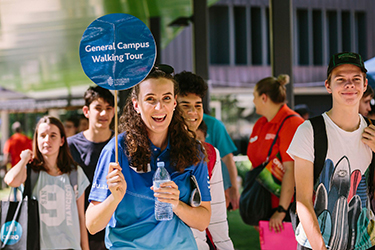
Take a video tour of our campus
Jcu cairns, nguma-bada campus, smithfield campus tour, jcu townsville, bebegu yumba campus, douglas campus tour, book your tour.
- *Please note. John Grey Hall is at 100% residential capacity. You will be able to tour all other accommodation facilities, but we will be unable to access individual student rooms. For a virtual tour, please visit the link here .
- Campus tours will be limited to smaller groups.
- If you are experiencing cold and flu like symptoms, please don’t attend your campus tour. Let us know and we can reschedule for another time.
Start your own story. Live on campus.
John grey hall.
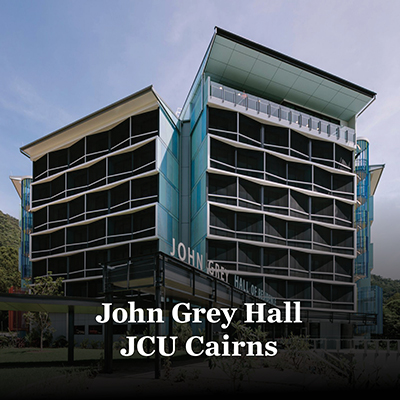
Saints Catholic College
JCU Townsville
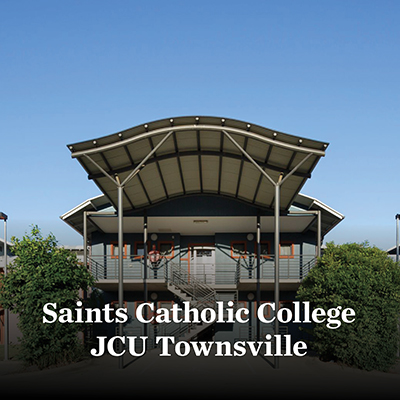
The John Flynn College
JCU TOWNSVILLE
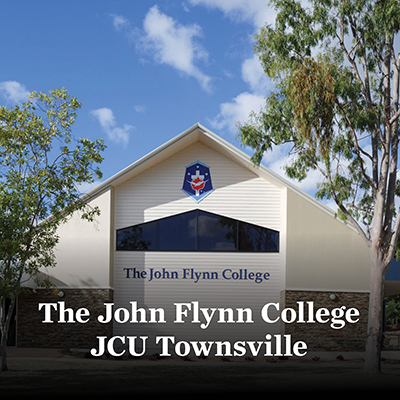
JCU Halls of Residence
Burralga Yumba JCU TOWNSVILLE

Rotary International House JCU TOWNSVILLE
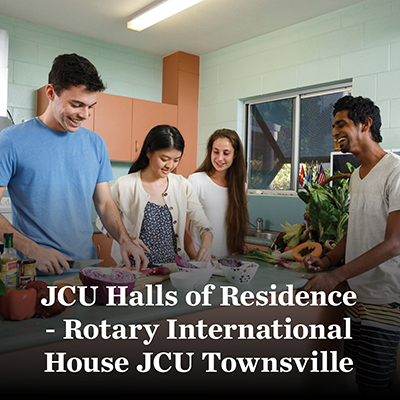
George Roberts Hall JCU TOWNSVILLE
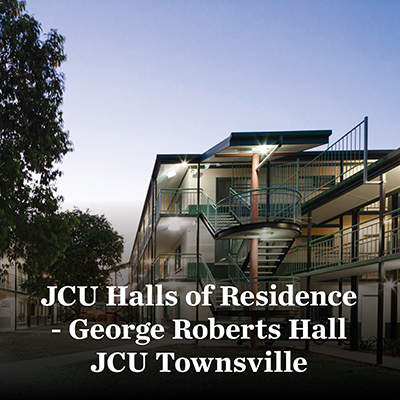
Download Course Guide
Thank you for completing the form..
You will receive an email that contains more information about JCU Pharmacy, with a link to the course guide (if you can’t see it, check your spam/promotions folder).
Learn how you can propel your career forward:
- Discover diverse pharmacy career opportunities
- Course information and requirements
Popular searches
Popular pages.
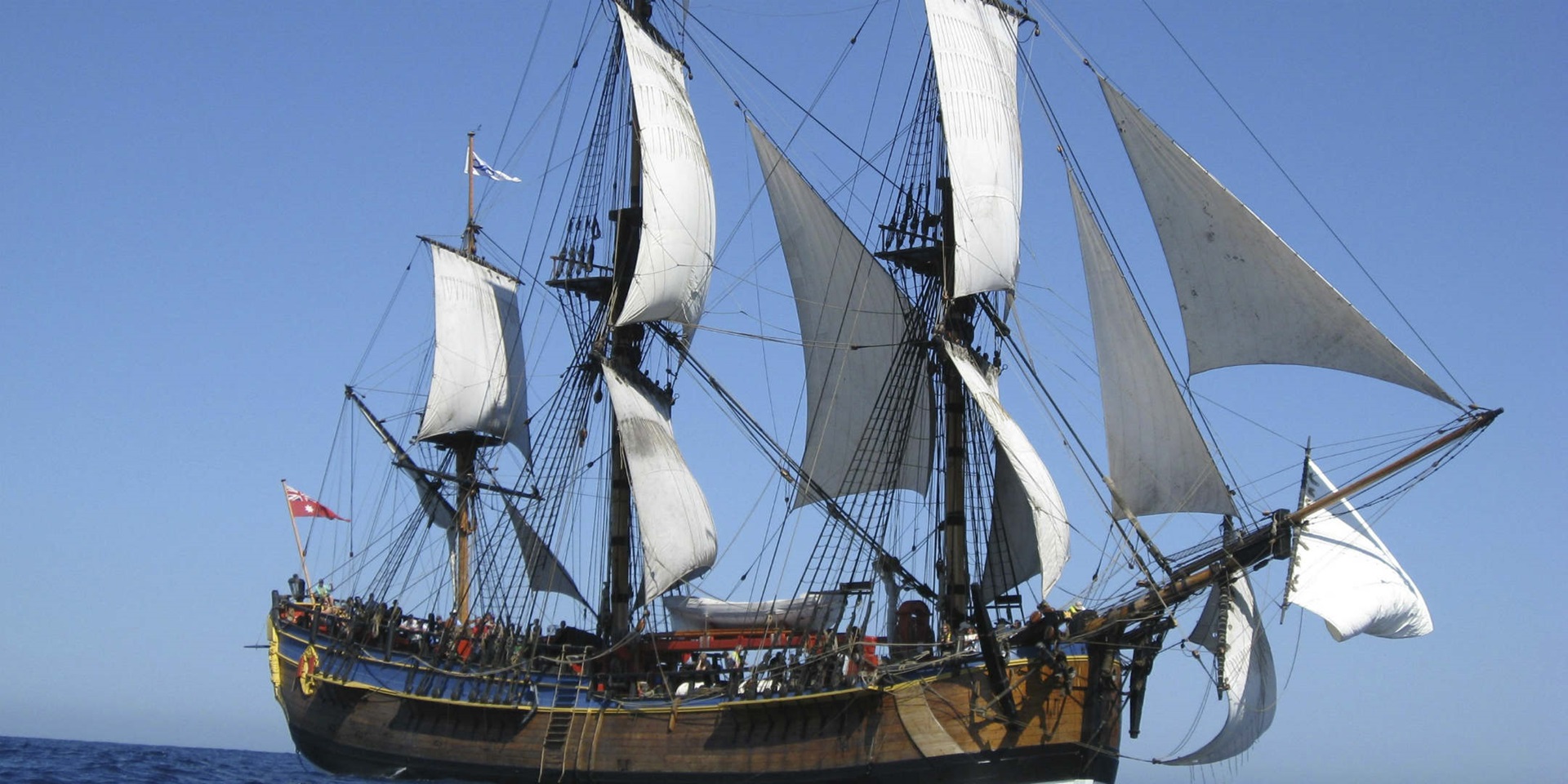
HMB Endeavour
Please note that the replica of HMB Endeavour is CLOSED from Monday 8 April and be away from the museum for essential maintenance.
The Australian-built replica of James Cook's HMB Endeavour is one of the world's most accurate maritime replica vessels.
When you come on board you may wonder whether James Cook and his crew have just stepped ashore somewhere on their voyage. The table is set , clothes are hung and the cat is slumbering.
On board the beautifully crafted ship, you glimpse a sailor's life during one of history's great maritime adventures, Captain Cook's epic 1768-71 world voyage. Look and you'll see almost 30 kilometres of rigging and 750 wooden blocks or pulleys! The masts and spars carry 28 sails that spread approximately 10,000 sq feet (930 m2) of canvas.
In the galley below is the huge stove, called a firehearth - state of the art in 1768. The Great Cabin is where Cook worked and dined, sharing the space with famous botanist Joseph Banks , as you can see when you glance around.
Construction of the Endeavour replica began in 1988 and the ship was launched 5 years later. Since then, Endeavour has covered many nautical miles on long voyages including circumnavigating Australia three times as well as sailing to Europe, the United States and a number of other overseas ports. Hundreds of thousands of visitors have come on board to see how Cook and his men lived.
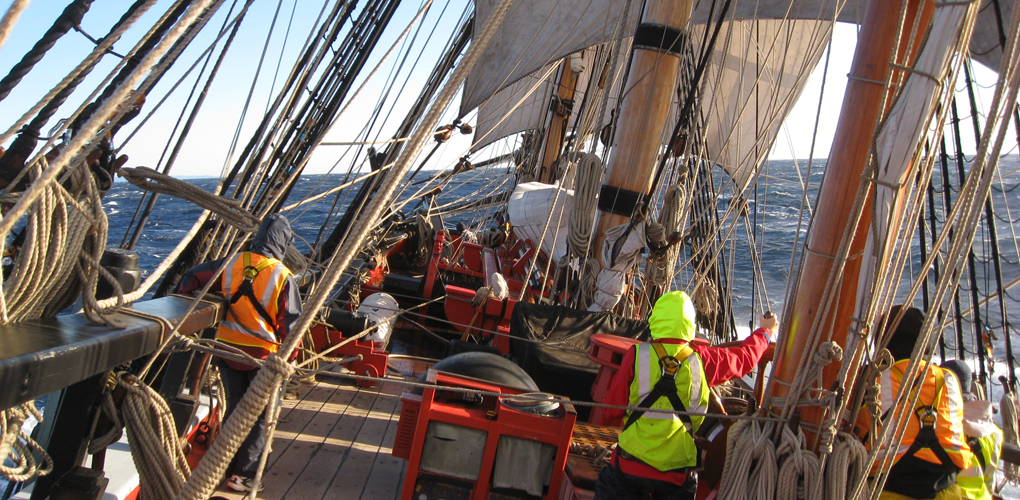
Visiting Endeavour
Most days, Endeavour stands majestically at our wharves open for visiting, but does enjoy regular trips along the Australian coast that the public can join, so be sure to check availability .
When it is out at sea, you can track the Endeavour over at marinetraffic.com (search for "HMB Endeavour ").
Sail the Endeavour
Endeavour is a fully functioning, sea-going ship and you can sail her as Voyage Crew or as a Supernumerary on 5-day and 10-day voyages at certain dates throughout the year.
Hire the Endeavour
Invite your guests to step on board the meticulous replica of Captain Cook’s famous and historic tall ship of discovery. Moored right beside the museum, HMB Endeavour is an outstanding venue for cocktails on the quarterdeck or an intimate dinner in the Great Cabin.
Search for Endeavour
Learn about the search for the HMB Endeavour - read the blog from our 2017 Rhode Island fieldwork team.
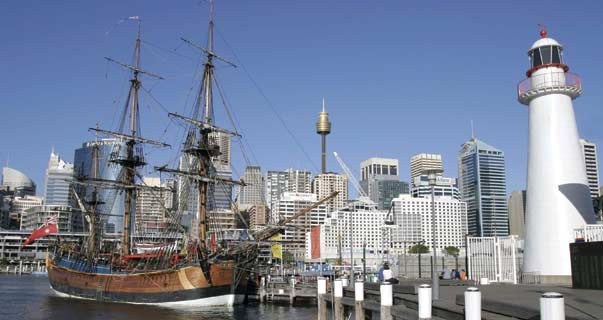
HIRE THE ENDEAVOUR
Invite your guests to step on board the meticulous replica of Captain Cook’s famous and historic tall ship of discovery. Moored right beside the museum, HMB Endeavour is an outstanding venue for cocktails on the quarterdeck or an intimate dinner in the Great Cabin.
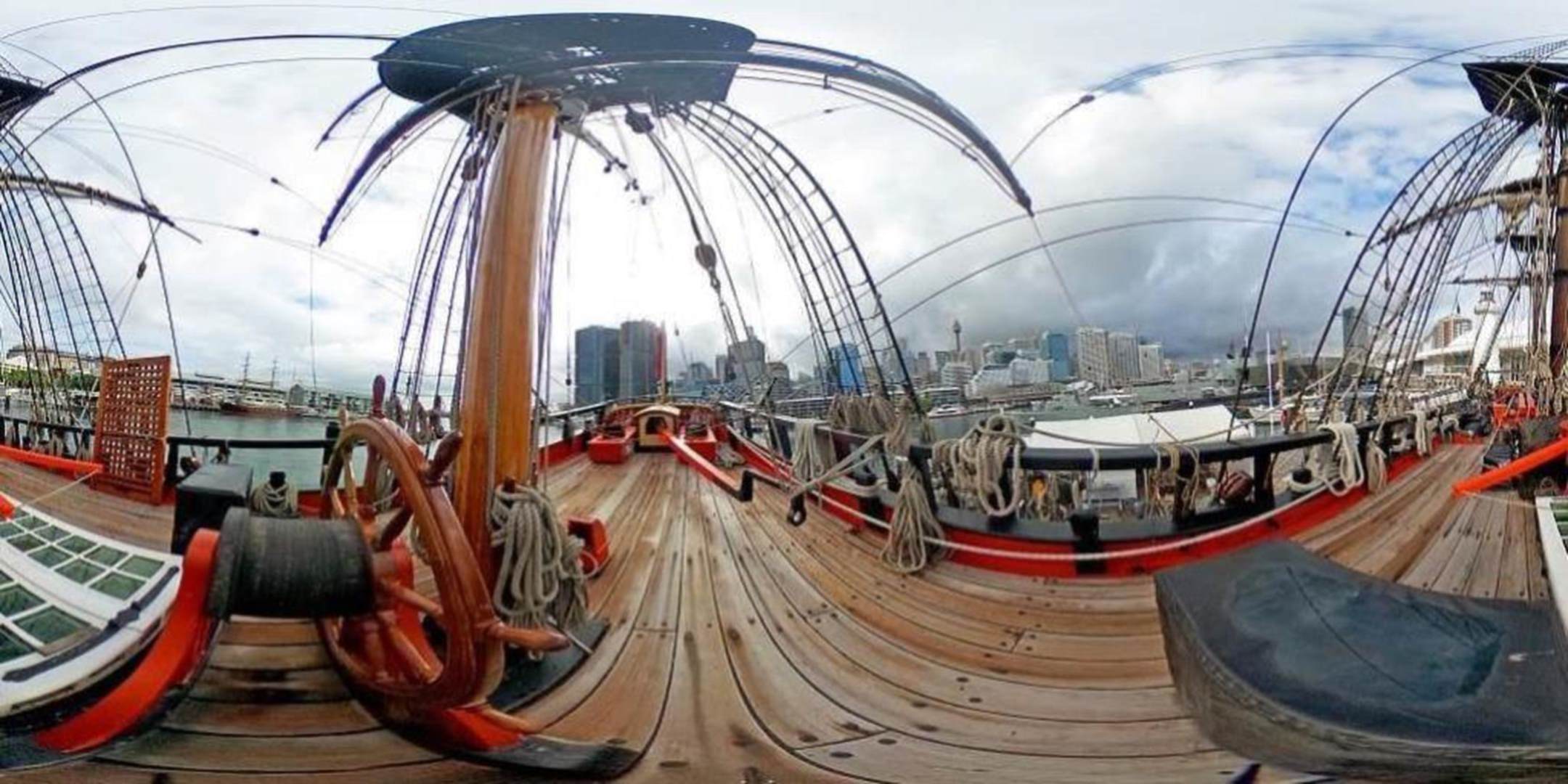
TAKE A VIRTUAL TOUR
Take a close up virtual tour
.jpg?h=720&la=en&w=1280)
Finding Endeavour
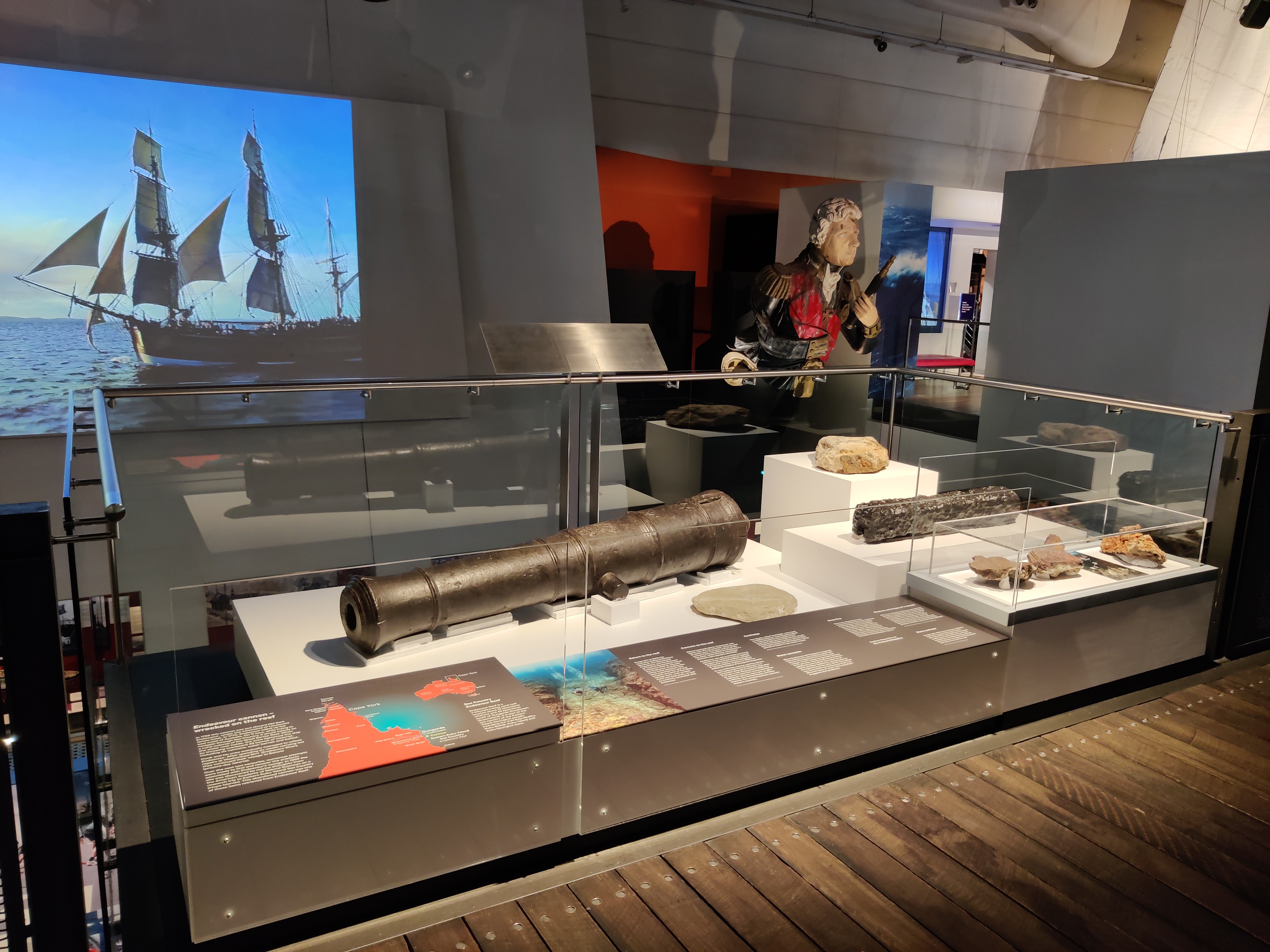
Endeavour Cannon on display
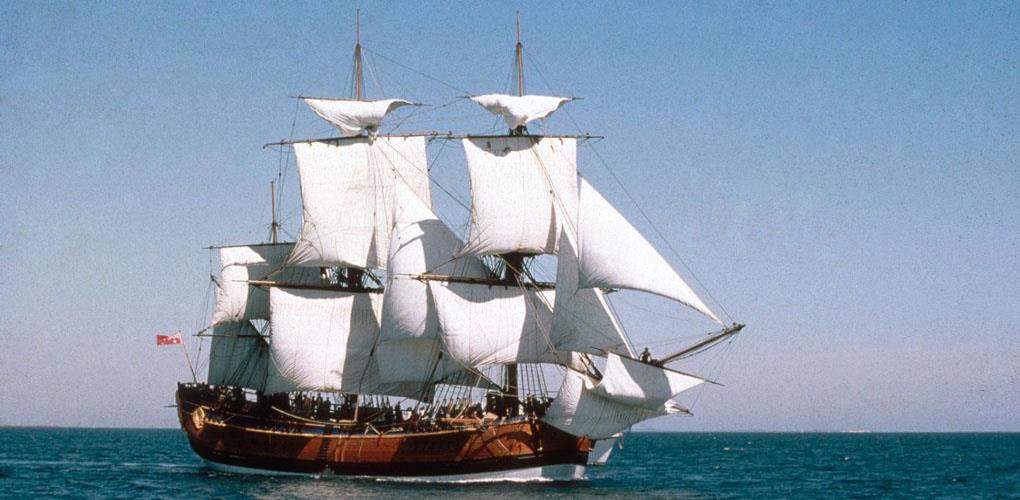
Ship specifications
Shop the Endeavour Store
Love Endeavour ? Explore our range of books and giftware relating to all things naval.
Take a Tour of HMB Endeavour
Dec 3, 2018 | Commemorations (2019x) , News
Climb aboard the magnificent Australian-built replica of James Cook’s Endeavour and tour one of the world’s most accurate maritime replica vessels. On board the beautifully crafted ship, you glimpse a sailor’s life during one of history’s great maritime adventures, Captain Cook’s epic 1768-71 world voyage.
When you come on board you may wonder whether James Cook and his crew have just stepped ashore somewhere on their voyage. The table is set , clothes are hung and the cat is slumbering. On board the beautifully crafted ship, you glimpse a sailor’s life during one of history’s great maritime adventures, Captain Cook’s epic 1768-71 world voyage. Look and you’ll see almost 30 kilometres of rigging and 750 wooden blocks or pulleys! The masts and spars carry 28 sails that spread approximately 10,000 sq feet (930 m2) of canvas. In the galley below is the huge stove, called a firehearth – state of the art in 1768. The Great Cabin is where Cook worked and dined, sharing the space with famous botanist Joseph Banks , as you can see when you glance around.
Construction of the Endeavour replica began in 1988 and the ship was launched 5 years later. Since then, she has sailed over 170,000 nautical miles twice around the world, visited 29 countries and many Pacific islands, and opened as a museum in 116 ports. Hundreds of thousands of visitors have come on board to see how Cook and his men lived.
To book tickets or take a virtual tour of the Endeavour, visit the Australian National Maritime Museum website.
- Search all content
- Search courses
- Browse study areas
About JCU Campus Locations, Maps and Transport Maps
- Aboriginal and Torres Strait Islander in Marine Science
- Future Students
- Current Students
- Research and Teaching
- Partners and Community
- Corporate Strategy
- University Plan
- International Engagement Strategy
- Innovation Strategy
- Impact Reports
- Annual Reports
- University Executive
- Divisions and Colleges
- Reputation and Experience
- Commitments
- University performance
- Building design
- Environmental and Sustainability Science
- Inspiration on Tap
- Mabo Decision: 30 years on
- Diversity and inclusion
- Midweek Mingle
- Social Sciences Week
- Law lectures and conferences
- Professional development
- Interim Sustainability Report 2022-2023
- Reconciliation
- JCU Cairns, Bada-jali campus, Cairns City
- Mackay Clinical School
- Rockhampton
- Thursday Island
- Townsville City Campus
- Celebrating 50 Years
- Anthropological Laboratory for Tropical Audiovisual Research (ALTAR)
- Anton Breinl Research Centre
- Agriculture Technology and Adoption Centre (AgTAC)
- Living on Campus
- How to apply
- Advanced Analytical Centre
- Aquaculture Solutions
- AusAsian Mental Health Research Group
- Association of Australian University Secretaries
- Australian Lions Stinger Research
- Australian Tropical Herbarium
- Australian Quantum & Classical Transport Physics Group
- Boating and Diving
- JCU-CSIRO Partnership
- Employability Edge
- Clinical Psychedelic Research Lab
- Centre for Tropical Biosecurity
- Career Ready Plan
- Careers at JCU
- Careers and Employability
- Chancellery
- Centre for Tropical Bioinformatics and Molecular Biology
- College of Business, Law and Governance
- College of Healthcare Sciences
- College of Medicine and Dentistry
- College of Science and Engineering
- Centre for Disaster Solutions
- Cyber Security Hub
- Cyclone Testing Station
- The Centre for Disaster Studies
- Daintree Rainforest Observatory
- Discover Nature at JCU
- Research Division
- Services and Resources Division
- Education Division
- Elite Athletes
- Environmental Research Complex [ERC]
- Fletcherview
- Foundation for Australian Literary Studies
- Gender Equity Action and Research
- General Practice and Rural Medicine
- JCU Orientation
- Give to JCU
- Art of Academic Writing
- Art of Academic Editing
- Graduate Research School
- Indigenous Education and Research Centre
- Indigenous Engagement
- Indigenous Legal Needs Project
- Inherent Requirements
- IsoTropics Geochemistry Lab
- IT Services
- International Students
- Research and Innovation Services
- JCU Eduquarium
- JCU Heroes Programs
- JCU Webinars
- JCU Global Experience
- JCU Ideas Lab
- JCU Job Ready
- JCU Motorsports
- JCU Turtle Health Research
- Language and Culture Research Centre
- Marine Geophysics Laboratory
- New students
- Off-Campus Students
- Office of the Vice Chancellor and President
- Virtual Open Day
- Outstanding Alumni
- Parents and Partners
- Pathways to university
- Pharmacy Full Scope
- Planning for your future
- Publications
- Professional Experience Placement
- Queensland Research Centre for Peripheral Vascular Disease
- Rapid Assessment Unit
- Researcher Development Portal
- Roderick Centre for Australian Literature and Creative Writing
- Safety and Wellbeing
- Scholarships
- Contextual Science for Tropical Coastal Ecosystems
- State of the Tropics
- Strategic Procurement
- Student Equity and Wellbeing
- Student profiles
- TropEco for Staff and Students
- TQ Maths Hub
- Unicare Centre and Unicampus Kids
- Work Health and Safety
- WHOCC for Vector-borne & NTDs
- Copyright and Terms of Use
- Australian Institute of Tropical Health & Medicine
Interactive maps
- JCU Townsville and Cairns Interactive Maps Link
- JCU Singapore
Transit and parking maps
- JCU Townsville, Bebegu Yumba campus, Douglas (JPG, 267 KB)
- JCU Cairns, Nguma-bada campus, Smithfield (PDF, 5938 KB)
Printable Maps
Jcu townsville, bebegu yumba campus, douglas.
JCU Townsville Campus Colour Map
JCU Townsville, Bebegu Yumba Campus Map Colour1 (PDF, 15090 KB)
JCU Cairns, Nguma-bada campus, Smithfield
JCU Cairns, Nguma-bada Campus Map Colour1 (PDF, 1166 KB)
JCU Cairns, Nguma-bada Campus Map Colour2 (PDF, 3117 KB)
JCU Singapore Campus
JCU Singapore Campus (PDF, 25494 KB)
JCU Singapore Campus Map2 (PDF, 25494 KB)
Having a problem with maps or have suggestions?
Log a service now enquiry.
- James Cook University
- Bachelor of Advanced Science
- Bachelor of Arts
- Bachelor of Biomedical Sciences
- Bachelor of Business
- Bachelor of Business / Laws
- Bachelor of Dental Surgery
- --> Bachelor of Early Childhood Education --> Bachelor of Primary Education --> Study Education Online -->